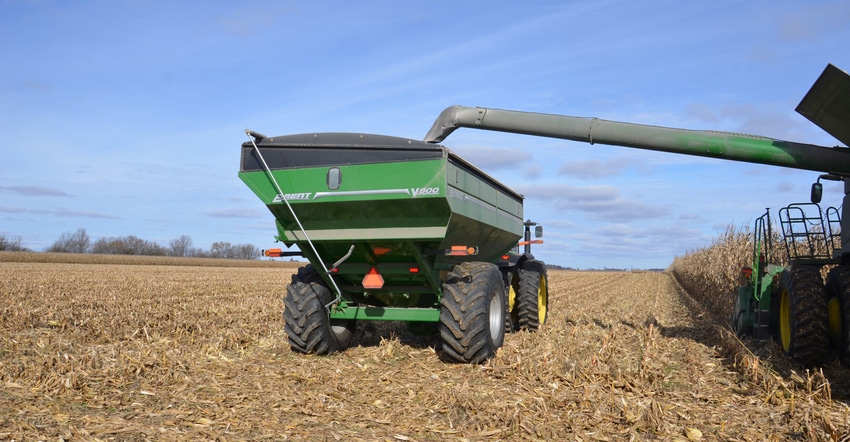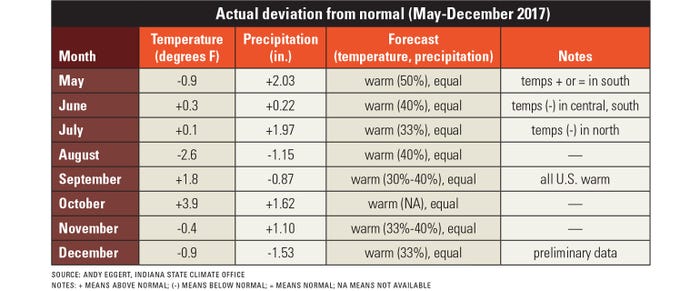
You read the long-term monthly forecast here each month. The form is now simpler so you can pick out the pertinent facts quickly. You want to know if it will be warmer or colder than normal. Will it be wetter or drier than normal?
From the beginning of the 2017 growing season through the rest of the year, it was a roller-coaster ride across much of Indiana — hot and cold spells, too much water at times, and too little at other times. How well did those monthly forecasts, issued about a week before the month began, fare?
You can see the results in the table below for May through December 2017 on a statewide basis. In a few cases, individual crop reporting districts fared differently. Note that for temperature, there were some hits with the forecasts and some misses.
“Remember that these are originally 90-day forecasts issued by NOAA’s Climate Prediction Center, which are then updated as the month approaches,” says Ken Scheeringa, associate climatologist with the Indiana State Climate Office. “We also include the percentage of confidence with the forecasts. In other words, the prediction may say there is a 40% chance that it will be warmer than normal.”
The other key point is it’s difficult to forecast in advance if factors that affect weather patterns aren’t showing strong patterns, Scheeringa says. That was the case for precipitation most of last year.
“The best we can do then is say there is an equal chance for drier, normal or wetter-than-normal conditions,” he says.
Month by month
Here’s how the growing season unfolded in 2017, month by month. Check the table below for exact details.
• May: The prediction in Indiana Prairie Farmer was a 50% chance of above-normal temperatures and equal chances on rain. Other than for some southern areas of Indiana, it was a cooler-than-normal, wet month. That’s a miss.
• June: Predictions called for above-normal temperatures and no guidance on rain. It was warmer than normal in the northern half of the state, but not by much. The state averaged slightly wetter than normal. That’s close to a draw.
• July: The forecast called for a warm month, but it averaged only 0.1 degree above normal statewide, and below normal in several districts. Rainfall was well above normal. Call it a draw!
• August: The monthly forecast called for warmer than normal with equal chances of rain. August was decidedly cooler and drier than normal. Cool weather likely contributed to higher-than-expected yields — a big miss on temperature.
• September: The CPC called for warmer weather across nearly the entire U.S., Scheeringa recalls. Indiana was 1.8 degrees above normal. The saving grace for corn turned out to be moderate to cool nighttime temperatures. This forecast was right on target.
• October: Forecasters called for above-normal temperatures, with no call on rainfall. Mother Nature delivered a warm month in Indiana, averaging 3.9 degrees above normal, allowing crops to mature. Rainfall was well above normal. The temperature forecast was a direct hit.
• November: Temperatures were supposed to be above-normal, but only a few counties in south-central Indiana saw that trend. Most of the state was slightly cooler than normal. Be generous and call it a draw.
• December: Only preliminary data was available, but it appears the month wound up below normal, temperature-wise. Predictions called for above-normal temps. The month was also much drier than normal. Count it as another miss.
Looking back, that’s three misses, two hits and three draws. Scheeringa’s advice? Keep looking at these forecasts, but also follow them online as updates are posted.

About the Author(s)
You May Also Like




